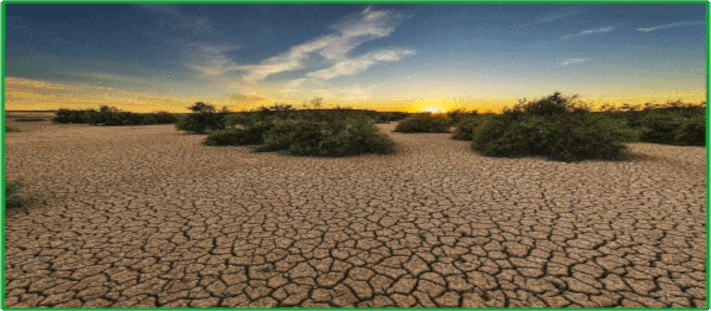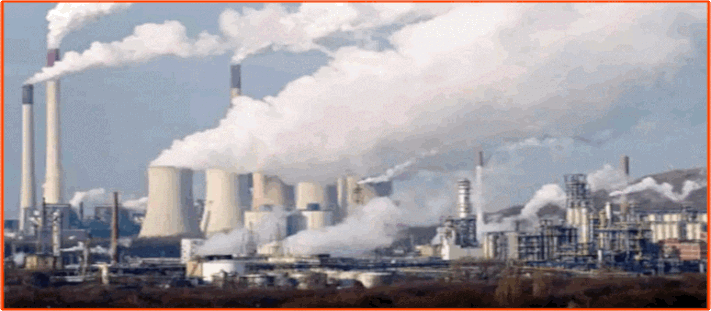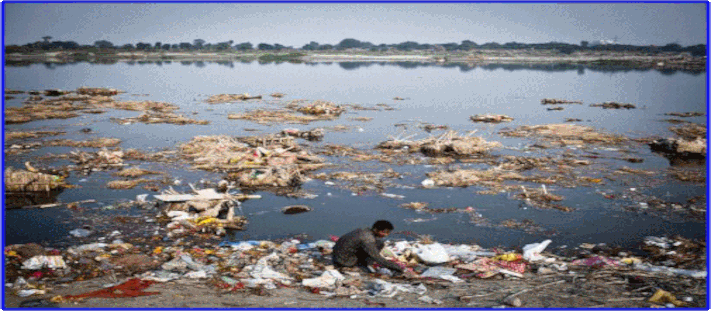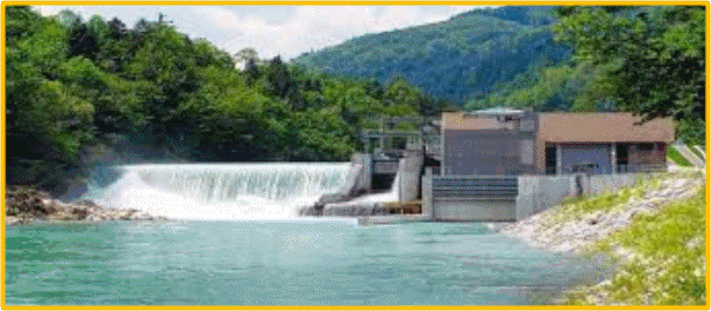Chapter 9:-
Environment and Sustainable Development.
Introduction As an economy develops, many of its problems get solved. Economic growth generates jobs, raises incomes and improves the living standards of the people. Growth and development lead to increased literacy and higher life expectancy. Thus, growth and development solve many problems. But, there is another side to this. Growth creates problems also. Industrialization is necessary for growth. Industrialization creates problems like environmental degradation, deforestation, over crowding in cities, etc. Development that destroys the environment is not sustainable. There are economists who believe that present patterns of development are not sustainable. We should aim at sustainable development. Sustainable development is development that can sustain itself, Sustainable development would be environment friendly.
A major problem that the present day world faces is the problem of environment degradation. Degradation of environment is creating many new problems like global warming and ozone depletion. Also, it is making development unsustainable. To understand these issues, let us start by examining the functions of the environment. Then we will go to the condition of India’s environment. We will conclude this chapter by discussing some strategies for sustainable development.What is Environment ?
Environment – Definition

- Biotic factors are all living things like plants, forests, fisheries, micro organisms, worms, insects, birds, animals, etc.
- Abiotic factors include air, water, sunlight, land, etc.
Functions of the Environment The environment performs a large number of functions broadly classified into four:
- Supplies Resources: All resources we use are supplied by the environment. There are Renewable resources and Non-renewable resources. Renewable resources are those that can be renewed. That is, their supply will not be exhausted with use. They will be continuously regenerated. Examples of renewable resources are water, alr, sunshine, fisheries, plants and trees, etc. Non-renewable resources are those that cannot be renewed. They cannot be regenerated. Their supply will be exhausted with use. e.g., coal, petroleum, minerals, etc.
- Assimilates Wastes: The environment has the ability to absorb wastes. Many organic wastes that we throw. out are absorbed by the soil and converted into manure.
- Sustains Life: Human life is supported and sustained by biological systems like crop lands, oceanic fisheries, fresh water systems and forests. Life is possible because of the genetic diversity and biodiversity provided by the environment.
- Provides Aesthetic Services: From space, the earth appears as abeautiful blue planet. The earth provides beautiful breath-taking scenery. Mountains, rivers, birds, animals, flowers… are all great aesthetic delights.
Carrying Capacity and Absorptive Capacity The environmental systems have a carrying capacity. If the utilization of resources is within the carrying capacity, utilization can be sustainable. But if utilization levels exceed the carrying capacity (regenerating capacity), the environment is degraded. This leads to environmental crisis.
Absorptive capacity is the capacity of the environment to absorb degradation. When pollution level and waste generation exceed tolerance limits, the environment gets damaged and degraded. Many rivers have dried up, lakes and ponds damaged and soil poisoned due to reckless exploitation. Humanity is nearing a devastating environmental crisis. Global warming and ozone depletion are major environmental threats of modern times.Environmental Crisis We are today at the threshold of environment crisis. Following are the main reasons for environment crisis.
- Rising population of developing countries.
- Affluent consumption and production standards of the developed world. Consequently, many resources have become extinct and the wastes generated are beyond the absorptive capacity of the environment.
- The past development polluted and dried up rivers and other aquifers with the result that water has now become an economic good.
- The intensive and extensive extraction of both renewable and non-renewable resources resulted in the exhaustion of vital resources. We are, therefore, compelled to spend huge amounts in R & D to explore new resources.
- Decline in air and water quality (70 per cent of water in India is polluted) have resulted in increased incidence of respiratory and water-borne diseases. This results in rising expenditure in health.
- Global warming and ozone depletion also contribute towards increased financial commitments for the government. Thus the opportunity costs of negative environment impacts are very high.
Reversal of Supply – Demand Relationship for Environmental Resources
(Is the environmental problems new to this country?) In the early period when civilisation had just begun or before increase in population and industrialisation, the demand for environmental resources was far below than their supply. It means that pollution was within the absorptive capacity of the environment. The rate of extraction of resources was less than that of regeneration and environmental problems did not arise.
At present demand for resources has gone beyond their supply. This has happened due to population explosion and the advent of industrial revolution to meet the growing needs of the expanding population. Thus the pressure on the absorptive capacity increased. We are now faced with increased demand for environmental resources and services. But their supply is limited due to overuse or misuse. Thus there occurred a reversal of supply-demand relationship for environmental resources.Global Warming

Factors contributing to global warming
- burning of fossil fuels like coal, petroleum, etc.
- animal dung (releases methane)
- Deforestation (reduces the carbon dioxide absorptive capacity)
Studies have shown that during the 20th century atmospheric temperature rose by 1.1 degree fahrenheit (0.6°C).
Consequences of Global Warming
- melting of polar ice
- climate change
- rising of sea level
- coastal flooding
- scarcity of drinking water
- extinction of many species
- drought and famine
- possibility of tropical storms
- tropical diseases
Kyoto Protocol A U.N. Conference on Climate Change was held in Kyoto, Japan in 1997 to find a solution to the problem of global warming. The conference resulted in an agreement called Kyoto Protocol. This protocol calls for reduction in green house gas emissions by industrialised countries.
U. N. Summit on Climate Change
(Copenhagen Summit)
Global warming and the consequent climate change is a major concern of the world presently. Global cooperation and action are necessary to tackle this problem. In this context, the United Nations took initiative to organise a conference on climate change, This conference was held in Copenhagen (Denmark) during December 7th to 18th 2009.
The Copenhagen conference recognised that climate. change is one of the greatest challenges of the present times and action should be taken to keep any temperature increase to below 2° centigrade. Unfortunately, there was no unanimous agreement acceptable to all countries. The Copenhagen Accord was drafted by U.S., China, India, Brazil and South Africa. The accord has been criticised since it is not legally binding. It does not contain any legally binding commitments to reduce CO2 emissions. India agreed to cut carbon emissions intensity by 20 to 25% (of 2005 levels) by 2020.Paris Agreement
The 2015 United Nations Climate Change Conference held in Paris negotiated the Paris Agreement, on the reduction of climate change. The text of the agreement represented a consensus of the representatives of the 196 parties attending it.
It was the 11th session of the Conference of the Parties to the 1997 Kyoto Protocol. At the Paris climate conference (COP 21) in December 2015, 196 countries adopted the first-ever universal, legally binding, global climate deal. The agreement sets out a global action plan to avoid dangerous climate change by limiting global warming to below 2°C.Ozone Depletion Ozone depletion refers to the phenomenon of reduction in the amount of ozone in the atmosphere.
Ozone layer in the atmosphere about twelve miles from the earth’s surface contains plenty of ozone. It prevents the sun’s harmful ultra violet light from entering the earth’s atmosphere, thereby functioning as a protective layer. This layer is now getting damaged by high levels of chlorine and other compounds released from the earth through human activity. Chloro- fluorocarbons (CFCs) are used in air conditioners, refrigerators, sprays, etc., release CFCs into the atmosphere causing ozone depletion.Causes of Ozone Depletion
- Chlorofluorocarbons (CFCs) used in airconditioners, refrigerators, sprays, etc., or
- As acrosol propellants and bromofluorocarbons (halons) used in fire extinguishers.
- damage to living organisms
- skin cancer
- damage to aquatic organisms
Montreal Protocol
A conference in Montreal, Canada, adopted the Montreal Protocol which bans the use of ozone depleting compounds such as CFCs. Now, CFCs are being replaced by Hydrofluorocarbons (HFCs) which do not damage the ozone layer.
State of India’s Environment India is blessed by nature with abundant natural resources. India’s rich environment consists of:
- Hundreds of rivers
- Lush, green forests
- Abundant mineral resources
- Vast coast line
- Plenty of mountain ranges
- High level of bio-diversity
- Rich quality soil
Chipko or Appiko Movement
Chipko movement aimed at protecting forests in the Himalayas. A similar movement took place in Karnataka (Salkani forest, in Sirsi district) called Appiko movement. 160 men, women andchildren hugged trees sending back the woodcutters. On getting the assurance from the officials that trees will be cut scientifically, the volunteers left the trees. Their movement saved 12,000 trees.
- India has 17 per cent of the world’s population.
- India has 20 per cent of the world’s cattle.
- But, India has only 2.5 per cent of the world’s geographical area.
- The per capita forest land is only 0.06 hectares against the requirement of 0.47 hectares.
- Land degradation
- Bio-diversity loss
- Air pollution (with special reference to vehicle pollution in cities)
- Water pollution
- Solid waste management
Land Degradation

- Deforestation
- Extraction of wood for fuel and fodder for cattle beyond sustainable levels
- Shifting cultivation (Burning down trees in an area, cultivating there and then moving on to another area to do the same)
- Open access resource
- Encroachment into forest land for cultivation
- Poverty of the agriculture dependent people
- Non-adoption of soil conservation measures
- Improper crop rotation
- Excessive use of chemical fertilisers and pesticides
- Excessive exploitation of ground water
- Use of fertile top soil for brick and tile making
- Forest fires and over grazing
- Improper planning and management of irrigation system
Air Pollution Air pollution means pollution in air caused when certain gases and particles are emitted into the air.
In India air pollution is widespread in urban areas. Vehicles are the major contributories to air pollution. In a few areas where there is high concentration of industries and due to thermal power plants, air pollution is very high.
- Vehicular emissions in urban areas have the maximum impact on the general population.
- Increase in the number of vehicles (3 lakh in 1951 and 30 crore in 2019) has contributed significantly to total air pollution load.
- India is one of the ten most industrialised nations of the world. This has brought with it various consequences such as unplanned urbanisation, pollution and the Risk of accidents.
- Gases like carbon monoxide, sulphur dioxide, carbon dioxide and suspended particles like lead are the major pollutants which cause many diseases and early deaths.
- The CPCB (Central Pollution Control – Board) has identified seventeen categories of industries (large and medium scale) as significantly polluting.
Water Pollution

- domestic waste water
- industrial waste water
- agricultural run off
Pollution Control Boards
In order to address two main environmental issues, viz., water and air pollution, the government set up the Central Pollution Control Board (CPCB) in 1974. The states also set up their own state level boards to address the environmental concerns. They investigate, collect and disseminate information relating to water, air and land pollution. They lay down standards for sewage /trade effluent and emissions. They assess the air quality through regulation of industries. The PCBs collect and disseminate data relating to water pollution. They monitor the quality of water in 125 rivers, wells, lakes, creeks, ponds, tanks, drains and canals.
Environment Protection
India’s environmental challenge is a serious one. Governments are now giving priority to protecting the environment. There is a ministry for environment. There are pollution control boards at the centre and states. There are large number of NGOs deeply committed to environmental issues. The Chipko Movement started for protecting forests in the Himalayas and the Appiko movement in Karnataka are great environmental movements. They have contributed substantially to creating awareness about environmental protection.
Sustainable Development Sustainable development is environment friendly development that sustains itself. It does not degrade the environment and damage the Prospects for future generation, The UN Conference on Environment and Development (UNCED) defines sustainable development as:
Sustainable Development
“Development that meets the need of the present generation without compromising the ability of the future generation to meet their own needs.”
- Limiting human population.
- Adoption of input efficient technology.
- Sustainable extraction of renewable resources, (This means that the extraction of renewable resources should not exceed their regenerative capacity).
- Limiting use of non-renewable resources below the rate of creation of renewable substitutes.
- Correcting inefficiencies arising from pollution.
- In 2015, the UN formulated 17 Sustainable Development Goals (SDGs) intended to be achieved by the year 2030.
Strategies for Sustainable Development Strategies for sustainable development should focus on prevention of environmental degradation by limiting the demands on environmental resources. This strategy comprises non-conventional sources of energy, adoption of traditional knowledge and practices, organic farming, etc.
Use of Non-conventional Sources of Energy Conventional sources of energy like thermal power and hydro power are highly damaging to the environment. Thermal power is generated by burning coal. This releases carbon dioxide (a green house gas) which adds to global warming. Hydro power generation requires construction of dams, This leads to deforestation and submerging of forest and agricultural lands. Sustainable development requires extensive use of non-conventional sources of energy like solar, wind, tide, etc.
LPG, Gobar Gas in Rural Areas


CNG in Urban Areas

Wind Energy

Solar Energy

Mini-hydel Projects

Traditional Knowledge and Practices Before industrialisation human life has been environment-friendly. Traditional knowledge was extensively used. For example, traditional plants and herbs were extensively used in medical treatment. India has around 15000 species of plants which have medicinal property. Many treatment forms of ayurveda have been recognised globally. If traditional knowledge and systems go out of use, they will be lost forever. This should not happen.
 Of late, there is a resurgence of some traditional systems. For instance, herbs are extensively used in the preparation of soaps, shampoos, creams, etc.
Of late, there is a resurgence of some traditional systems. For instance, herbs are extensively used in the preparation of soaps, shampoos, creams, etc.
Organic Farming The Green Revolution is a major landmark in India’s economic history. It gave us self sufficiency. in food grains. It also created many adverse environmental impacts. Extensive use of chemical fertilisers and pesticides degraded the quality of land. Food Products became contaminated. It even poisoned water bodies and ground water systems. A sustainable alternative is organic farming. Two important elements of organic farming are:

- Biocomposting
- Biopest control
Biocomposting Biocompost is compost made from organic waste. Cattle dung, bird droppings, green leaves, etc., are very good biofertilisers. The quality of agricultural produce made from biocompost is much superior to that of agricultural produce cultivated using chemical fertilisers.
Biopest Control Biopesticides are produced from plant products. Neem and tobacco are good biopesticides. Mixed cropping and crop rotation are also effective in controlling pests. Different species of animals and birds also play an important role in pest and insect control. Pest and insect eating birds are natural remedy to the pest problem.
Sustainable development has become a ‘manthra’ of modern times. Many sustainable development activities have been initiated in many countries. But, we have a long way to go.Conclusion Sustainable development should minimize environmental problems meeting the needs of the present generation without compromising the prospects of future generations.
![]()

